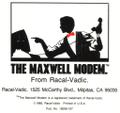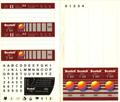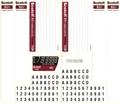new things for March 2011
Before Smart Phones was France's Minitel.
Originally intended as an online phone directory, it grew into an online service
for shopping and information, paving the way for The Internet.
Teletext is the UK/North American version that was essentially stillborn
by the quick adoption of BBS-style systems and data services
and then standards-based communications (HTML, TCP/IP).
Here's a 1990s brochure for Mnematics Videotex.
Their web page seems to be dead
but there's apparently still a Mnematics Inc at 9 William St, Sparkill NY 10976.




The first modems were "dumb": could not even dial for themselves,
thus the rotary phones with the "data" button instead of "hold".
Then came "smart modems" with an embedded microprocessor (often a Z80).
This is because most modems were used directly by a human using a terminal,
not by an auto-dialer program or terminal emulator.
The Hayes command set became the de-facto standard, but most also offered more
user-friendly menus and options such as non-volatile memory for storing
commonly dialed numbers.
Most dialup systems had alternate numbers to use when the primary numbers were all busy,
so the modem allowed programming chains of numbers to auto-dial if one didn't connect.
Over time, PC internal modems became "value engineered" and the menus were deleted
since they were used via PC programs, not directly like external modems.
To further lower the cost, most of the DSP was also removed,
thus the brain-dead "win-modems" that require CPU cycles to make up for the missing hardware.
The
Novation Apple-Cat modem
was one of the first Apple ][ internal modems,
popular for its ability to dial the 4th column A-D (see
Autovon)

Here's the cover from my Maxwell Smart-modem. Sorry about that, chief!


Here's the cover from the Zenith Data Systems ZTX-11 terminal manual.
It LOOKED like a Commodore 64: everything was built into the keyboard.
But it was a terminal that used a composite monitor and either the built in modem or
RS232 port for an external modem or to anything else!

Life used to be so simple: just upgrade the CPU with the Intel OverDrive Processor!



Egghead used to have REAL brick-and-morter STORES!
This is probably when I bought my Palm Pro PDA, when it was the "best" model available
for only $379.94.

The "hand scanners" have been re-invented as stand-alone scanners to flash cards.

Brochure from
The Boston Computer Museum
(closed in 1999)



Back in the 70s to 80s, there were many mail order electronics surplus catalogues,
mostly in the Boston area.
Poly Paks was the most infamous, for they sold factory rejects
such as faulty chips and wire with uneven insulation, but cheap enough that we bought it anyway.

More "value engineering" at work: the ever diminshing VHS label






























